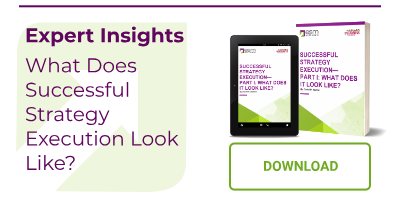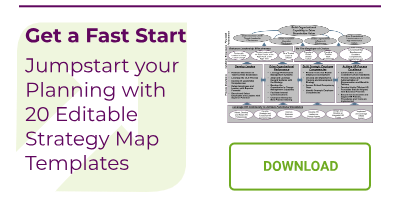Introducing our Anniversary Series
A quarter-century ago, we set out to solve a problem that seemed both simple and impossibly complex: how do you turn strategic plans into strategic results?
Twenty-five years later, that fundamental challenge remains unchanged. While we’ve supported over 2,000 organizations over this time to bridge the gap between boardroom vision and day-to-day execution, we know that there are many more out there who continue to struggle. Leaders still wrestle with aligning their teams around common goals. And employees still crave understanding of how their work truly matters.
What has changed is everything else. The tools we use, the pace of business, the expectations of employees, the complexity of markets, and the sophistication of how world-class organizations approach strategy execution. We've witnessed transformations that seemed impossible in 1999—from rigid, top-down hierarchies to agile, purpose-driven cultures where every employee thinks and acts strategically.
Over the next several months, we'll be sharing the most significant shifts we've observed across the organizations we've had the privilege to serve. From the evolution of employee engagement to the revolution in performance measurement, from the rise of real-time strategy management to the transformation of organizational culture itself.
Some things change. Some things endure. The best organizations master both.
From Siloed to Strategic: How World-Class Organizations Transformed Employee Engagement in 25 Years
Part 1 of our ESM 25th Anniversary Series
Twenty-five years ago, when we first started helping organizations bring their strategies to life, employee engagement looked very different. Back then, most companies treated strategy as a boardroom exercise—something that happened at the top and trickled down through disconnected processes, fragmented goals, and annual reviews that felt more like performance theater than meaningful development.
Fast forward to today, and we're witnessing a fundamental shift in how world-class organizations think about their people. As we kick off our 25th anniversary celebration, there's no better time for a mid-year health check on where HR strategy and employee engagement stand—and where they're headed.
The Great Awakening: Every Employee is Strategic
The most profound change we've observed isn't technological—it's philosophical. Organizations have finally awakened to a truth that was always there but rarely acknowledged: every employee is a strategic employee. While technology supports vital aspects of change management in an organization, the philosophy of employee empowerment and engagement stems from a culture of inclusiveness around strategy.
 Gone are the days when strategy was the exclusive domain of the C-suite, with everyone else relegated to "execution mode." Today's leading organizations recognize that the receptionist who creates the first impression, the software engineer who spots a critical bug, and the customer service rep who turns an angry customer into a brand advocate are all making strategic decisions every day.
Gone are the days when strategy was the exclusive domain of the C-suite, with everyone else relegated to "execution mode." Today's leading organizations recognize that the receptionist who creates the first impression, the software engineer who spots a critical bug, and the customer service rep who turns an angry customer into a brand advocate are all making strategic decisions every day.
This shift from "us and them" to "we" has been nothing short of revolutionary.
Breaking Down the Silos: From Fragmented to Unified
Remember the old playbook? Leadership would craft a strategy in isolation, HR would create separate engagement initiatives, and individual departments would set goals that may or may not align with the bigger picture. The result? A workforce that was busy but not necessarily strategic, engaged but not necessarily in the right direction.
The transformation we're seeing in world-class organizations is remarkable. They cascade their strategy from corporate to business and support units and then to the individual level. We’ve witnessed their shift from disjointed processes to beautifully orchestrated corporate strategies where every role, every team, and every individual understands exactly how their daily work contributes to the organization's trajectory.
This isn't just about communication—it's about fundamentally reimagining how work works.
The Empowerment Evolution: From Tasks to Outcomes
Perhaps the most exciting transformation we're witnessing in 2025 is how world-class organizations are completely reimagining their approach to work itself. They're moving away from the traditional "here's your job description, follow these 47 steps" mentality to something far more powerful: outcome-focused empowerment.
The shift is profound. Instead of dictating the "how," leading organizations are getting crystal clear on the "what" and "why"—then trusting their people to figure out the best path forward. They're saying, "Here's the outcome we need to achieve, here's how it connects to our strategy, now show us your best thinking on how to get there."
This isn't just about flexibility or work-from-home policies. It's about fundamentally redesigning how humans and organizations interact. The 2025 organizational design trends we're seeing emphasize people over process, with companies actively reshaping roles to allow employees to thrive and contribute their unique strengths, rather than forcing square pegs into round holes.
Think about it: when you hire talented people and then micromanage exactly how they do their work, you're essentially paying for their hands while ignoring their brains. The organizations that are winning today have figured out how to engage the whole person—their creativity, problem-solving ability, and strategic thinking—not just their task-completion skills.
This outcome-oriented approach creates something remarkable: employees who don't just execute strategy, but who actively contribute to and refine it through their daily work. When people understand the outcome and are empowered to determine the method, they become strategic partners rather than tactical resources.
Measuring Up, Paying Up: The New Benchmark for Excellence
What separates world-class organizations from the rest isn't just that they've made this philosophical shift—it's that they've built systems to measure, manage, and reward it. They've moved beyond basic engagement surveys to sophisticated frameworks that track how well employees understand their strategic role, how aligned their goals are with corporate objectives, and how effectively they're contributing to shared outcomes.
 These organizations don't just hope their people are engaged—they create the conditions for strategic engagement and measure it relentlessly. To reinforce the behavior, they link their reward system to the organizational, team, and individual metrics. The individual is not successful unless the team is successful and the team is not successful unless the organization is successful. Integral to a performance-based culture is setting clear expectations and ensuring leaders at all levels lead by example. Trust employees to deliver the results and reward them when they do.
These organizations don't just hope their people are engaged—they create the conditions for strategic engagement and measure it relentlessly. To reinforce the behavior, they link their reward system to the organizational, team, and individual metrics. The individual is not successful unless the team is successful and the team is not successful unless the organization is successful. Integral to a performance-based culture is setting clear expectations and ensuring leaders at all levels lead by example. Trust employees to deliver the results and reward them when they do.
A Culture of Strategic Contribution
Perhaps the most telling change is cultural. We're seeing organizations where employees regularly discuss how their work connects to strategy, where performance conversations focus on strategic impact rather than just task completion, and where recognition celebrates both individual achievement and collective strategic progress.
As one of our clients put it: "ESM is so easy to use and supports an amazingly wide range of strategy needs. It is a very smart investment" - but more importantly, it's helped them create a culture where "ESM allowed us to move from a reactive organization to a proactive organization. We are finally able to focus on making strategic decisions, rather than the process of gathering information."
This cultural shift represents an appreciation for employee contributions that simply wasn't present 25 years ago. It's not enough to be a good performer in your role—today's employees are expected to be strategic thinkers who understand how their piece fits into the larger puzzle.
The Mid-Year Reality Check
As we reach the midpoint of 2025, it's worth asking: Where does your organization stand on this continuum? Are your employees strategic partners in your success, or are they still operating in isolated functional silos?
The organizations that have made this transformation aren't just seeing better engagement scores—they're seeing better business results. When everyone understands how they contribute to the strategy, when goals are truly aligned across the organization, and when performance is measured against strategic impact, extraordinary things happen.
Looking Ahead: The Next 25 Years
As we celebrate 25 years of helping organizations bridge the gap between strategy and execution, we're more excited than ever about what's possible. The shift from siloed to strategic isn't just a trend—it's the foundation for how successful organizations will operate in an increasingly complex and competitive world.
The question isn't whether this transformation will happen in your organization—it's whether you'll lead it or be forced to catch up.
Ready to transform how your organization thinks about employee engagement and strategic alignment? We'd love to show you how world-class organizations are making this shift. Request a demo to see how you can move from siloed to strategic.
About ESM Software: ESM Software helps teams design, execute, measure and optimize their strategic plans with industry-leading software and coaching. Our integrated suite of cloud-based applications was built to meet your strategy and execution needs, with solutions for strategy management, risk/compliance, employee performance management, and operational scorecards.






